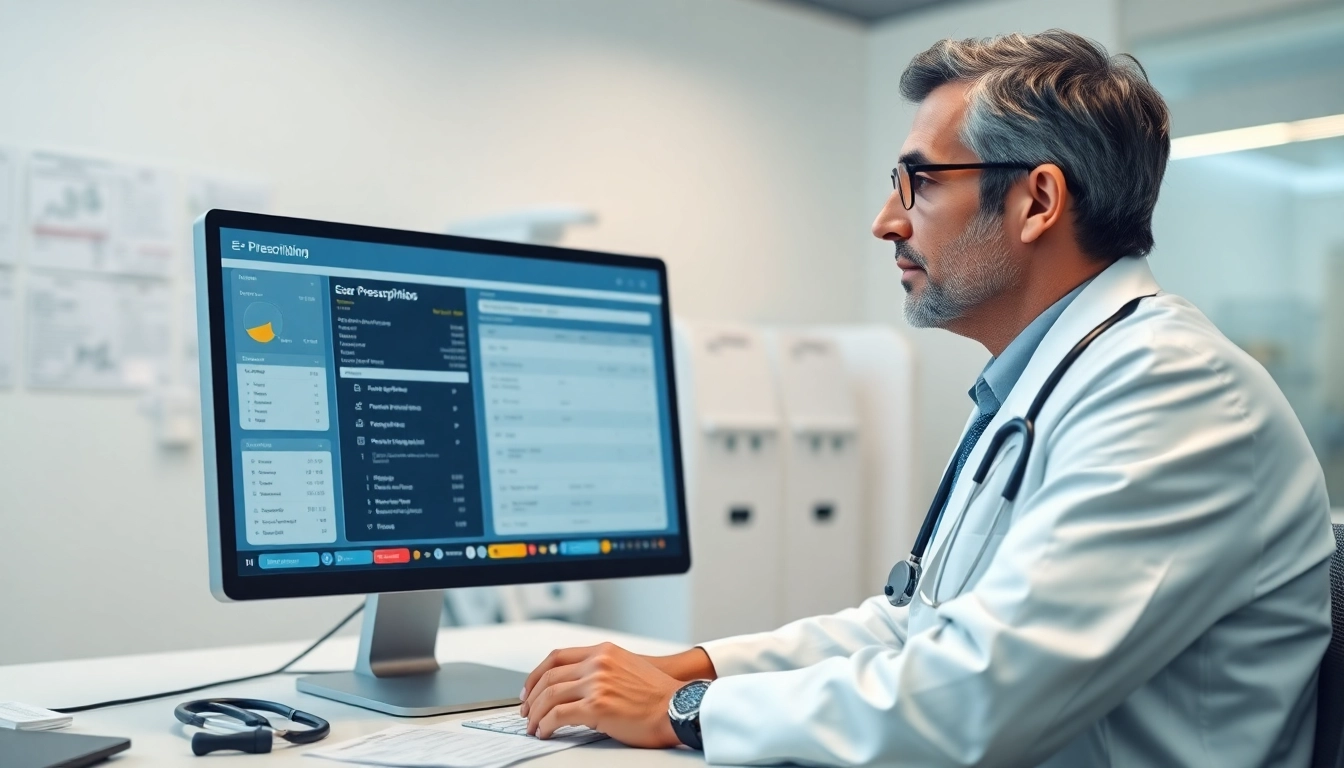The transition from traditional paper prescriptions to electronic prescriptions (ePrescriptions) represents a significant advancement in the healthcare industry. As digital healthcare continues to evolve, ePrescribing has emerged as a vital tool for improving patient care and enhancing the efficiency of medical practices. This article takes an in-depth look at the landscape of ePrescribing apps, focusing on their key features, user experiences, and evaluations, while providing a comprehensive analysis of the best options currently available.
Understanding ePrescription Apps
What is an ePrescription App?
An ePrescription app is a digital tool that allows healthcare providers to create, send, and manage prescriptions electronically. Instead of relying on paper prescriptions, which can be prone to errors and misinterpretations, these apps streamline the prescribing process, providing a more reliable and efficient model for patient care. Through the use of these applications, healthcare professionals can issue prescriptions directly to pharmacies, reducing the chances of medication errors, improving patient safety, and saving time for both the provider and the patient.
Key Features of ePrescription Apps
ePrescription apps come equipped with a range of features designed to enhance usability and functionality. Some common features include:
- User-Friendly Interface: Most ePrescription apps focus on delivering an intuitive interface, which simplifies navigation and improves the overall user experience for healthcare professionals.
- Medication Database: A comprehensive database of medications that includes dosing information, contraindications, and interactions helps providers make informed prescribing decisions.
- Patient Management: Features for managing patient profiles, including medical histories and previous prescriptions, can enhance the accuracy of prescribing and improve patient outcomes.
- Real-Time Updates: Integration with pharmacies allows for real-time updates on medication availability and pricing, ensuring that patients receive the most relevant and timely information.
- Connectivity: Many ePrescription apps offer seamless integration with Electronic Health Records (EHR) systems, facilitating a smooth workflow.
Importance of ePrescription Apps in Healthcare
The relevance of ePrescribing in modern healthcare cannot be overstated. These applications contribute to numerous positive outcomes:
- Improved Accuracy: By minimizing transcription errors and awkward handwriting, ePrescription apps ensure that prescriptions are accurate and easily readable.
- Enhanced Efficiency: Automating the prescription process saves time for both healthcare providers and pharmacists, leading to increased patient throughput and satisfaction.
- Better Communication: ePrescription apps promote better communication amongst healthcare providers, patients, and pharmacies, leading to improved care coordination.
- Reduced Costs: By minimizing errors, reducing paper use, and increasing the efficiency of prescription management, ePrescribing can lead to cost savings for healthcare facilities.
Evaluating ePrescription App Reviews
Criteria for Evaluating ePrescription App Reviews
When diving into ePrescription app reviews, it’s crucial to assess them based on specific criteria:
- User Experience: Reviews should highlight how easy the app is to navigate and use, including onboarding processes, support availability, and overall functionality.
- Performance: Stability and speed are essential factors; the app should perform well under various conditions without crashes or bugs.
- Customer Support: Availability and responsiveness of customer service play a critical role in mitigating challenges users may encounter.
- Integration Capability: Effective integration with existing systems, such as EHRs, can enhance the app’s value.
- Feature Set: Evaluations should also consider the range and effectiveness of features available within the app.
Common User Feedback and Experiences
User feedback is invaluable in understanding how well ePrescription apps perform in real-world settings. While individual experiences can vary widely, common themes often emerge from the reviews, including:
- Users frequently cite a seamless prescription process, leading to faster medication delivery.
- Many providers appreciate the built-in safety checks that alert them to potential drug interactions.
- However, some users express frustration with occasional connectivity issues or the learning curve associated with new systems.
Understanding Ratings and What They Mean
Ratings are a straightforward way to assess the quality of an app, with higher scores generally indicating more positive user sentiments. Here’s how to interpret ratings effectively:
- 4-5 Stars: Typically signifies a well-received app with features that meet the needs of healthcare providers effectively.
- 3 Stars: May suggest room for improvement; while the app serves its primary function, users may encounter usability or performance issues.
- 1-2 Stars: Often indicative of significant problems—whether technical, support-related, or feature limitations—suggesting prospective users exercise caution.
Top ePrescription Apps in 2025
Leading ePrescription Apps According to User Reviews
Based on comprehensive analyses and user reviews, several ePrescription apps stand out for their features and reliability. Apps frequently mentioned in the top ranks include those that provide robust performance, user-friendly designs, and comprehensive customer support.
Comparative Analysis of Popular ePrescription Apps
When considering which ePrescription app to choose, a comparative analysis can be beneficial. Factors to consider might include:
- Pricing Models: Some apps adopt subscription-based models, while others may offer pay-per-use options. Understanding the cost structure can affect long-term budgeting.
- User Base: Apps catering to a broader range of medical specialties may offer more diverse functionalities than those targeting niche markets.
- Updates and Enhancements: Frequent app updates indicate a commitment to user experience and the introduction of new features aligned with industry needs.
Unique Features that Stand Out in ePrescription Apps
Beyond basic functionalities, unique features can elevate certain ePrescription apps above others. Some noteworthy features might include:
- Telehealth Integration: Allowing providers to prescribe medications during virtual visits enhances flexibility and care accessibility.
- Smart Alerts: Automated notifications that remind patients of refill needs or alert providers of abnormal lab results related to prescribed medications.
- AI-Powered Recommendations: Some apps utilize AI to suggest medications based on patient history and latest clinical guidelines.
Challenges with ePrescription Apps
Common Issues Reported in ePrescription App Reviews
- Connectivity Problems: Many users face interruptions in internet service that hinder app functionality, impacting the prescribing process.
- Learning Curve: New users may struggle initially with navigating the app’s features, which can lead to decreased efficiency temporarily.
- Data Security Concerns: Protection of sensitive patient data is paramount, but some apps have been critiqued for not having robust security protocols in place.
How to Overcome Barriers in Adopting ePrescription Apps
To ensure successful adoption, addressing common barriers is essential:
- Training and Support: Providing comprehensive training sessions and ongoing support can ease the transition for users reluctant to switch from paper to digital.
- Reinforced Infrastructure: Ensuring that there are strong IT support and backup plans can mitigate connectivity issues when they arise.
- Data Governance Protocols: Implementing strict security protocols to protect patient data will help to build trust among users.
Strategies for Optimizing ePrescription App Usage
To maximize the benefits of ePrescription apps, users should adopt the following strategies:
- Regular Updates: Keeping the app updated not only enhances security but also ensures access to the latest features and improvements.
- Collecting User Feedback: Encouraging feedback from other users can help identify common pain points and foster a sense of community for shared learning.
- Utilizing Integrative Functions: Take full advantage of any integrations with EHR systems to streamline workflows and enhance overall efficiency.
Future of ePrescription Apps
Trends Shaping the Future of ePrescription Apps
The landscape of ePrescribing is continually evolving, influenced by several trends:
- Increased Incidence of Telemedicine: The growth of virtual care will continue to drive the demand for more sophisticated ePrescription solutions that integrate seamlessly with telehealth services.
- Patient-Centric Design: Future developments are likely to prioritize patient usability, featuring tools that empower patients to manage their prescriptions and engage in their healthcare actively.
- Artificial Intelligence Utilization: AI will play a growing role in prescription accuracy and patient recommendations, leveraging patient data to enhance outcomes.
Technological Innovations on the Horizon
Emerging technologies are set to redefine ePrescription apps further. Innovations may include:
- Blockchain Technology: Implementing blockchain can enhance data security and transparency, securing patient records against unauthorized access.
- Mobile Access Enhancements: As mobile device usage continues to increase, apps will likely adopt more mobile-friendly features, such as voice-activated commands for easier accessibility.
- Machine Learning Insights: Apps could begin leveraging machine learning to analyze prescription patterns and derive insights for better clinical decision-making.
Regulatory Changes Affecting ePrescription Apps
As the regulatory landscape concerning healthcare continues to evolve, it is crucial for ePrescription app developers to stay abreast of legislative changes. Potential upcoming regulations might focus on:
- Data Privacy Standards: Heightened focus on patient data protection could lead to stricter compliance requirements that apps must adhere to.
- Standardization of Processes: The push for standardized protocols may help facilitate greater interoperability across various ePrescription systems.
- Monitoring Prescribing Practices: Increased regulatory scrutiny could also lead to tools that help monitor practitioners’ prescribing behaviors, ensuring compliance with best practices and reducing misuse.
In conclusion, the world of ePrescription apps is rich with insights and opportunities that continue to evolve at a rapid pace. As healthcare professionals navigate this landscape, understanding the various applications, their features, and user experiences will empower them to make informed decisions. For those interested in eprescription app reviews, focusing on these key aspects can yield valuable insights aiding in the selection of the right tools that enhance patient care and streamline workflows.



